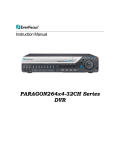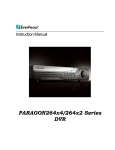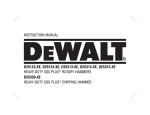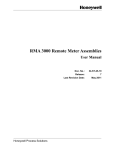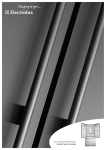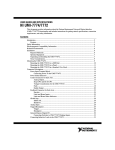Download Vista QP16 series Specifications
Transcript
pp2-3_000_Benchmark_feb11 11/02/2011 15:16 Page 1 A TOUCH TOO FAR? Biometric reader solutions tested for accuracy BENCHMARK TESTED: SCB-3001 SV DSP Camera • SNB-5000 HD 720p iPolis camera AROUND THE CLOCK A comparative test of IR-enabled static domes OPEN ALL HOURS A look at the leading day/night cameras SAMSUNG PRODUCT TEST ROUND-UP pp2-3_000_Benchmark_feb11 11/02/2011 15:16 Page 2 Standing out from the crowd? PRODUCT Everfocus 264x4 Honeywell HRDP16D Mitsubishi DX-TL5716E Samsung SRD-1670DP Vista QP16 PRODUCT DESIGN 88% 76% 80% 90% 80% FEATURES AND FUNCTIONS 86% 76% 80% 90% 80% VIDEO QUALITY 88% 80% 80% 90% 78% PERFORMANCE 86% 76% 80% 90% 80% OVERALL RATING 87% 77% 80% 90% 79% To identify products quickly and easily, always mention Benchmark when contacting suppliers and manufacturers. ne of the greatest myths about CCTV is that end users are more than happy to pay for systems which record time-lapsed video. In the past, the limitations of magnetic tape forced a situation where multiplexed timelapsed video was a necessity. As the technological barriers have been eroded, so the expectations of CCTV have been raised. Indeed, if you ask most end users what they want from CCTV, it would be high resolution images, in real time, all of the time! It’s when the cost of that is realised that compromise starts to creep in. In recent times, manufacturers have looked to deliver recording solutions that offer higher frame rates. With the advance of digital technology, it becomes increasingly obvious that real-time is not only desired, but in many applications it is demanded. To not meet this demand would be to lose out on vital contracts, and so frame rates have gradually increased. The main focus of the test is to consider whether these machines are capable of O Samsung SRD-1670DP + A genuine real-time DVR at all resolutions - A few more global options in the menus might be nice 2 www.benchmarkmagazine.com delivering higher levels of performance than standard DVRs, which are very widely available in the CCTV sector. If so, does the processing capability deliver the specified performance, or do the units creak when put under pressure? Samsung SRD-1670DP The SRD-1670DP from Samsung is billed as a real-time DVR, and supports up to 16 video inputs with loop-throughs via BNC. The main video output is via BNC, VGA or HDMI. There are four spot monitor outputs using BNC. The unit has some serious processing power. It also offers a high level of flexibility, featuring 10/100/1000 LAN connectivity, alongside RS485 and RS-232 data connectivity. The unit also features three USB ports and two external SATA ports. Two of the USB ports are conveniently located on the front of the unit, with one on the rear panel. The DVR supports two-way audio with 16 inputs and 1 output. The inputs are handled by way of four phono sockets, with the remaining inputs connected via a D-Sub socket. The audio output is also phono. The unit also boasts 16 alarm inputs and 4 alarm outputs. A DVD rewriter is included. pp2-3_000_Benchmark_feb11 11/02/2011 15:16 Page 3 16 Channel DVRs The DVR uses the now almost standard H.264 compression algorithm for recorded video. Available resolutions are 704 x 576, 704 x 288 or 352 x 288. Record rate is 400fps. Now for the good news; it’s 400fps at all resolutions, so this truly is a real-time DVR! The SRD-1670DP has a clean and simple fascia. The left hand side is home to the DVD rewriter, while the centre of the unit includes a jog/shuttle dial with a blue LED ring. It’s a small touch, but it does give a quality feel, and end users like that. Consumer brands don’t spend a fortune on such touches for nothing, so it’s good to see security products following suite. There are two main blocks of buttons. The first is the 16 channel select buttons, and the second includes general control and playback, as well as a touchpad for menu navigation. The recorder is supplied with a manual. It is fairly well written and covers most of what you’ll need to know. There is also a mouse included, and an infrared remote control unit, as well as SATA connection leads for external devices. The menu structure is straightforward. It differs from the traditional Samsung menus we’ve seen in the past, but before you wonder why they’d change it, the good news is that it’s better! Navigation is clear and easy, and the settings are simple to control. Inputs are individually configurable, and you do have to set each one. Thankfully, when it comes to setting schedules, you can apply global changes, which made the configuration very quick. Additional functionality such as alarm handling, motion detection and search facilities are simple and work well. Video quality has eight settings; thankfully Samsung has had the good sense to not try and come up with 8 descriptions. Instead they vary from Level 1 (lowest) to Level 8 (highest). The only anomaly is that the machine offers 4CIF, 2CIF and CIF resolutions, but the menu refers to them as D1, Half D1 and CIF. It’s not an issue as the specification sheets are very clear about what you actually get! At Level 8 in 4CIF mode, the image quality is excellent. Indeed, many would be hard-pressed to differentiate it from a live input. Being able to record in real time across the board might have an impact on storage capacity, and installers offering the highest quality could need to fill the unit’s five HDD slots, but if you’re after real time, video, it’s worth it! Dropping to Level 5 in 4CIF doesn’t show much deterioration, and Level 3 only shows signs of compression in bland areas of tone. Even at Level 1, identification is still possible, and we have seen worse images from some DVRs on their so-called high quality settings. Obviously, dropping to CIF resolution does have a slight impact, but nowhere near as much as you might expect. At Level 8 the images are similar to what you’d expect from a decent 4CIF MPEG-4 images, and for a CIF resolution that shows that the H.264 implementation has been done with care. At around Level 4 compression is obvious, but not to the degree that it renders the image unusable. Even at Level 1, you are getting images that are more than good enough for general surveillance! Verdict The Everfocus Paragon 264x4 is a very good machine, and if we’d been sent a manual and a power lead – and if the manual had decent instructions about fitting the drives – we’d have been happier. That aside, the GUI, whilst not difficult to use, isn’t as intuitive as some of the others. However, you can forgive it that because of its performance. Honeywell’s HRDP16D is a basic general purpose DVR. When Benchmark established the base specification for what the DVRs needed to achieve, the unit was accepted as the spec seemed to indicate that the unit would provide a higher frame rate for high resolution images. It doesn’t, and with a maximum rate of 50fps for 4CIF images, it can’t compete in this company. For this reason it receives a lower rating. Against run-of-the-mill DVRs, it’s certainly a nice unit. Mitsubishi’s DX-TL5716E has been around for a fair few years now, and whilst it’s still capable, it does seem to have been left behind by the pack! Given that in its day it was the ‘cooking’ version of the powerful DX-TL5000, it was certainly once way out in front in terms of performance. It has now been overtaken, and is crying out for a performance boost. The Samsung SRD-1670DP packs in a lot of performance given its price, and it uses that performance to deliver the type of image quality, in real time at all resolutions, that you’d expect from a higher end DVR. Compression is very well implemented, and the GUI is simple and intuitive. It’s hard to find fault with the unit. Vista’s QP16 has some good points; it equally has a few points that could be improved on. The noisy fans rule it out for some applications, and a reworked GUI would give it a more updated feel. However, the performance suffers if the image quality is reduced to its lowest level, and that puts it behind a few others in the test. Best Buy – Samsung SRD1670DP The SRD1670DP represents where mainstream DVRs will be going in the near future. It has power, high image quality, a simple GUI, and is built to a high quality. It achieves all of this in a rather under-stated way. It is interesting that the two best performers in the test – Samsung and Everfocus – were both relatively new DVRs. In recent times, processing capabilities have moved on, and the result is that newer units are able to fully exploit that additional performance. The SRD1670DP, however, squeezes a little bit more out of it, and that makes it the Best Buy! www.benchmarkmagazine.com 3 pp2-3_000_Benchmark_feb11 11/02/2011 15:16 Page 4 The Next Step for CCTV? Samsung – SNB-5000 Camera 84% BENCHMARK RATINGS Product Design: 85% Features and Functions: 85% Ease of Installation: 80% IVA Performance: 85% Video Performance: 87% Overall Rating: 84% Tel: 01932 455308 www.samsungsecurity.com f there is one technology that will drive forwards the acceptance of new technologies in CCTV, it has to be High Definition video. It has a wide range of benefits, and not all of them are technological! Indeed, HD also could help future installations leverage more cost-effective components, as well as produce systems hat are easier to sell. The latter benefits are only benefits if the technology delivers, and HD does. A typical D1 image contains around 440,000 pixels, and a good D1 image is more than enough for many applications. A HD 720p image delivers more than twice that amount of information in each frame, coming in just shy of 1 megapixel. A HD 1080p image will further double this resolution, with a final image that contains more than four times the detail of a standard D1 image. As well as higher resolutions, there are benefits such as digital zooming, plus HD is a standard, so you know what you are getting if the product bears the HD logo. Finally, the increased use of HD will allow sites to leverage most cost-effective 16:9 displays, plus the marketing of HD in the consumer sector means that end users are aware of the benefits available. With so many positives, it is no surprise that Samsung has incorporated HD performance into its SNB-5000. I Specifications The SNB-5000 from Samsung delivers a HD 720p image. The camera also 4 www.benchmarkmagazine.com When considering the role of video as a security tool, High Definition cameras make a lot of sense. Now Samsung has released its latest HD camera, but does it add benefits to an increasingly active market? supports 4:3 megapixel resolution, with a maximum of 1280 x 1024, as well as SVGA, VGA and QVGA. The camera makes use of H.264, MPEG4 and MJPEG. Frame rate is real-time for all resolutions except the 1280 x 1024 highest setting, which is limited to 22 frames per second. The camera uses a 1/3 inch progressive scan CMOS sensor, which utilises the Samsung Wisenet processing engine. This equips the camera with a host of functions including SSDR (Samsung’s dynamic range feature), SSNR III (the noise reduction system), BLC with highlight compensation, intelligent video analytics (object appear/disappear, entry/exit and virtual tripwire), multiple streaming and SD/SDHC card support. The former gives up to 2GB of storage, the latter a more usable 32GB. The camera is supplied with Samsung’s Net-i software package, which allows licence-free video management and archiving. Other features include two-way audio, basic alarm handling, day/night switching and the usual settings for camera configuration. One small touch that will be welcomed by installers is the inclusion of a BNC connector. This simplifies set-up as the camera can be quickly connected to a test monitor. It’s also a real benefit when trying to pp2-3_000_Benchmark_feb11 11/02/2011 15:16 Page 5 Professional Test adjust the lens. Lag can make focussing an IP camera something of a nightmare, so it is certainly a positive move. Installation and set-up The hardware installation is simple. It's very similar to the set-up for a composite video camera, but there is obviously the network connection to add. This is a simple RJ45 connection. Once the connections are made, the next task is to address the camera. Samsung supplies a utility for this. It runs from the CD, and so does not need to be installed on the machine. Our first attempt saw the program blocked. An attempt to allow it to continue resulted in the machine locking up, before restarting. Our second attempt saw the firewall disabled and the utility run in Administration mode, and this resulted in it working as expected. Once the camera is found you can login using the master username and password, and then you are prompted to install Microsoft Silverlight to render the video. This is simple, although the install did hang for a minute or two at the end. Once completed, the iPolis viewer screen loads and the video can be configured. Installation is simple; the security settings of the base machine will determine whether or not the utility works first time. We feel our test unit may have been too secure for the task of searching all connected network devices. Otherwise, it is straightforward. There is a printed Quick Start guide, but if you need more detail, the full manual is only supplied as a PDF document on a CD. Performance In recent times, Benchmark has looked at a number of HD cameras, and what has been interesting is that often the best image quality, for a general view, is in 720p mode. Of course, much depends on the balance between image quality and processing capabilities. With the SNB-5000, the only HD resolution is 720p. Whilst many people seek out 1080p, the reality is that if correctly set up, you’ll only really notice the difference is you employ digital zoom. The camera does also offer 1.3 megapixel resolution in a 4:3 format, but the quality isn’t really different to the HD 720p image. Colour fidelity is high, and there’s no real obvious bias towards either warmer or cooler tones. Definition is certainly high, and fine detail is very well preserved. Even with minimal compression and high bit-rate, motion is smooth, and whilst it will always have some slight lag, the Samsung camera is very good. Raising the compression and tweaking the settings does allow any ‘jitters’ in the image to be tuned out. One of the more interesting functions is the IVA. Benchmark has tested a composite camera with this functionality, and found it impressive, even though it is basic. On the SNB-5000, it is slightly simpler to set up, and with a few tweaks it soon becomes an efficient tool. The SNB-5000 includes numerous features typical of the Wisenet and SV-V platforms; both are very similar, with the former for network cameras and the latter for composite models. As such, this camera can be considered as a higher resolution top-end Samsung camera, and that’s not a bad thing to be! In summary In recent years, Samsung has established its cameras as more than capable of holding their own against the leading models in the marketplace. The SNB-5000 carries this on, with HD 720p or 1.3 megapixel performance. The market-place for HD cameras is growing, and there are now some cost-effective HD 1080p models appearing. That’s what we expect this camera to develop into, and we are eagerly awaiting that move. www.benchmarkmagazine.com 5 pp2-3_000_Benchmark_feb11 11/02/2011 15:17 Page 6 The Hybrid Advantage PRODUCT Axis Q7401 Genie CCTV NV100 Samsung SNS-100 Verint S1950e Videcon VIP-R200 Vista VKEncoder1 BUILD QUALITY 85% 85% 85% 80% 80% 85% FEATURES AND FUNCTIONS 85% 80% 85% 80% 80% 80% EASE OF INSTALLATION 85% 80% 80% 70% 80% 85% PERFORMANCE 90% 80% 80% 80% 80% 85% OVERALL RATING 86% 81% 83% 78% 80% 84% The choice between IP-enabled and composite systems is not a simple one to make. Each has it upsides and its downsides. That said, a mix and match approach can see systems benefit from both technologies. In short, a hybrid approach makes a lot of sense. Although there are advocates of using single technologies, the only sensible approach is to adopt a hybrid stance. After all, is it vital that all data in a security system is transmitted in the same way? Of course it’s not; all that really matters is the quality of the final image, and its ability to be used in the way that the end user requires. Fitness for purpose is the main concern with CCTV. It is vital that the system does what it was designed to do. How it achieves this, in terms of which cabling infrastructure it uses, is a secondary concern, and always will be. That’s why hybrid systems make sense; installers can freely select the best solution without fear of compromise. In some applications, different parts of the site will have varied needs. A ‘one size fits all’ Samsung SNS-100 + Solid performance and easy to configure - Slightly slow when changing configurations 6 www.benchmarkmagazine.com approach could be a compromise. The video server is one element of a CCTV system, and has a simple job to do. It encodes composite video so that it can be transmitted, viewed and managed via a network. It is an in-stream device, in that it sits silently somewhere in the system. It might be located at the control room, it might be at the camera, it could be anywhere in the system. It simply converts one type of signal into another. So, what is there to choose between such units? As with all Benchmark tests, the products were tested simultaneously in a real-world environment. The network was clean and only incorporated the tested servers. Additionally, performance was retested with each server as the sole device on the network, ensuring that any bandwidth-hungry units did not adversely affect the others. The main areas for consideration were ease of installation (including the usefulness of supporting documentation) and video performance. Some of the units include audio coding, but for the purposes of this test, the feature was not assessed. Samsung SNS-100 The SNS-100 encodes video at a rate of up to 25fps with a maximum resolution of 4CIF. The pp2-3_000_Benchmark_feb11 11/02/2011 15:17 Page 7 Video Servers server offers both MPEG-4 and M-JPEG coding. This allows video to be optimised for streaming using lower bandwidths, whilst delivering higher quality images for evidential purposes. Network support is for 10/100 BaseT. The server also handles bi-directional audio, alarm inputs and outputs, RS-232 and RS-422/485 ports, and a front-mounted USB 2.0 connection. Features of the SNS-100 include video motion detection, basic telemetry control, and alarm management. The unit is supplied with a PSU, resources CD, a real paper manual, a network cable and push-fit connectors for the alarm I/O. Installation and configuration of the SNS-100 is straightforward, and there won’t be any issues for installers. The unit is supplied with a preconfigured IP address. The installer only needs to ensure that the PC is on the same network segment, and then it’s a simple task to log in and perform the set-up. Once connected, the interface is relatively clean, and it feels intuitive. There are no issues with regard to settings, and it all feels very CCTV-related. There are five quality settings, and with the highest level selected, M-JPEG images are detailed and clean with high colour accuracy. Dropping the settings does increase the level of artefacting with fast moving objects, but there isn’t a point when the images become unusable. This is true for both algorithms. Lag is also minimal. The very lowest settings are best reserved for general observation, but the middle to high quality settings all deliver good quality images. Functionality is good, and the only thing that might be considered an issue is that the unit is slower than most servers when changing configurations. That said, once set-up, you’re unlikely to be messing around with the configurations anyway. Verdict Axis Communications’ Q7401 is certainly a high quality unit. It does its job well, is easy to use, and image quality is high. The unit represents a good choice for installers, and few will be disappointed by it. The NV-100 from Genie CCTV is a basic but functional unit. It’s easy to set-up and the interface is straightforward. A manual and a PSU would be nice; that said, it’s an economical alternative even with the need for a PSU factored in. Samsung’s SNS-100 has been around for a few years now, but it still delivers the goods. The trend towards H.264 does deliver higher quality than MPEG-4, but Samsung has implemented their compression well, and both the MPEG-4 and M-JPEG images are above average! Verint’s S1950e does deliver a good image, but it seemed to be more bandwidth hungry than the other units. That said, it did deliver minimal lag with depth of colour and detail when given higher bit rates. The lack of a CD was difficult to justify; it cost the unit marks. Videcon’s VIP-R200 has motion tracking as a headline feature, but as a video server it does deliver a cost-effective solution. It might not have the configuration flexibility of some units, but if you just want to encode video, it does the job. Vista’s VK Encoder 1 is a basic unit that is simple to configure, and that delivers good quality video. It holds its quality well, and is a good entry level option. www.benchmarkmagazine.com 7 pp2-3_000_Benchmark_feb11 11/02/2011 15:17 Page 8 A Touch Too Far? PRODUCT GSD 1FP Fingerprint Switch Samsung SSA-S3010 PRODUCT DESIGN 80% 80% FEATURES AND FUNCTIONS 80% 85% INSTALLATION 85% 80% PERFORMANCE 85% 85% OVERALL RATING 83% 83% hen biometrics first burst into the mainstream access control marketplace many years ago, it was greeted with near hysteria by some. A few over-eager manufacturers praised it to the rafters, even predicting the death of the traditional lock and key! Whilst that might have been a little overthe-top, it does indicate the level of optimism that some felt about the technology. Others viewed the technology as solely designed for high-end military-type applications. They saw it as a specialist solution that few in the wider world would be able to appreciate, understand or accept. They claimed it was too complicated, too processorhungry and too expensive. They also claimed that some users would feel violated by the technology and would fear for their privacy. Whilst fingerprint readers seemed to be the dominant technology, there were also a number of manufacturers and suppliers who wanted to expand the offering. Available technologies included hand-writing recognition, iris scanning, voice recognition, retinal scanning, hand geometry mapping, vein recognition and a host of other technologies. Whilst much of this is pretty damning for the technology, the situation has changed. Processing power and storage capacities have risen dramatically, thanks to the consumer market, and as a result prices have also fallen. The processing and storage concerns of biometrics a decade ago no longer exist. There is more than enough processing power and distributed storage available, all at very low costs. Additionally, the rise in use of biometrics for IT-based network and computer log-on has seen economies of scale realised for the reader elements, predominantly in the fingerprint scanning sector. Does this mean that costeffective biometric access control has finally become a reality? To identify products quickly and easily, always mention Benchmark when contacting suppliers and manufacturers. W 8 www.benchmarkmagazine.com Samsung SSA-S3010 Samsung’s SSA-S3010 is billed as a standalone fingerprint/smartcard/prox/PIN access control/time and attendance reader. If you think that sounds like a lot of functionality, it is. It could even be argued that most users won’t demand such a range of performance from a standalone reader, and the truth is that few will. However, for installers, if you want a onesize-fits-all approach to access control, then this unit will suit a myriad of applications. For our purposes, the test will concentrate on the pp2-3_000_Benchmark_feb11 11/02/2011 15:17 Page 9 Biometric Readers elements as per the original product specification for a standalone biometric reader. Supporting up to 1,000 users with fingerprint (other technologies have differing capacities), the unit allows the biometric element to be used with a PIN, or with other supported access technologies. The unit supports door monitoring and connection of a request-to-exit button. It also features two auxiliary outputs. Other functions include scheduling including holidays, data back-up, selectable door open time (0-99 seconds)and a duress alarm. The unit is tamper-protected, and includes a rear bracket for simple mounting. Power input is 12V DC. The reader is manufactured from polycarbonate, and its dimensions are 192 x 160 x 44mm. No IP rating is given, and a look at the product quickly tells you that it is not intended for external use. This does somewhat limit its potential for access control applications, especially those requiring protection of an entry point on top of a building. The SSA-S3010 is supplied with fixing screws, various diodes, push-fit cable connectors, a quick start guide and a full manual on CD. If you need the full manual, and our guess is that you will, it’s 80 pages long, and the translation isn’t the best. That said, you will be able to understand it. Installation is relatively simple, as all cabling connections are catered for with push-fit connectors. Flyleads are included. There are six connections in all, and these are not labelled. They are for power input, input/output, relay wiring, RS-232/RS-485 connection and two extension connections. There is also a TCP/IP port. Once the connections are made, the unit is fixed to the separate mounting bracket. This needs to be done to close the tamper switch. On power up, the unit emits a short tone via its integral speaker, and the buttons are illuminated. The screen flashes up a message, and then unit speaks to you. Whilst we’re sure it’s not polite to laugh, we sadly did. The speaker quality isn’t brilliant, so it did have a strangely comedic quality about it. Programming is carried out via 12 function buttons, which share the fascia with the numeric keypad. Programming is fairly simple, and if you only want to use the fingerprint element, then it’s also a fast process. However, if you want to do more, you need to check the manual, which spreads some of the instructions around on different pages. Inevitably, by the time you’ve found the parts you need, the programming mode will have timed out. One of the team did come up with a theory. His thinking was that Samsung – who more often than not do deliver a proper manual – opted not to print one until the translation was improved on! Let’s hope so; if that is the case, we’ll let you know! Generally, the unit works well. Entry attempts are responded to by the voice message, but if you go into the Time Schedule menu, you can mute this. This can be done by schedules, although we opted for turning it off altogether! Accuracy of the system was good, and it coped well with high traffic periods. Time for access to be granted was around 2 seconds. We tried the usual issue with wet hands. The Samsung unit did cope with generally damp fingers; it only rejected wet fingers. Verdict The 1FP Fingerprint Switch from GSD is a low cost standalone device that performs well. It is easy to install, simple to configure, and the unit does what is expected from it. The only very slight niggle is that a clearer explanation of the user code in the manual would save a little confusion. The SSA-S3010 from Samsung is a good unit. It does offer a lot of flexibility, but you have to ask whether you’re going to need it all in a standalone reader. Obviously the unit is a part of a larger range, so much of the functionality has been inherited from higher spec models. It could be immediately improved with a well written hardcopy manual. We also felt that we’d happily forgo some of the advanced features for a housing that delivers external use. Both units do the same job, but in different ways. The GSD unit is quick, simple, low cost and effective. For many, it will be an ideal standalone reader. The Samsung unit isn’t as simple, but it’s certainly not a headache either. You do get extra functionality, and there’s more flexibility than you will need in the vast majority of applications. Essentially, both products are recommended for differing reasons. Neither will disappoint! Samsung SSA-S3010 + Plenty of flexibility with regard to configuration - A proper manual, with a rewrite, would simplify installation www.benchmarkmagazine.com 9 pp2-3_000_Benchmark_feb11 11/02/2011 15:17 Page 10 Professional Test Pushing the boundaries? Samsung – SCB-3001P 90% BENCHMARK RATINGS Product Design: 90% Features and Functions: 90% Ease of Installation: 90% Image Quality: 90% Performance: 90% Overall Rating: 90% Tel: 01932 455308 www.samsungsecurity.com 10 www.benchmarkmagazine.com In recent years, Samsung has delivered a steady stream of camera upgrades. Does the latest SV-5 chip-set add more to an already high performance range? he CCTV sector is effectively at a crossroads when it comes to technology. The established composite video that has served us so well over the recent decades is, according to some, past its sell-by date, and the new broom of networked video is going to clean up! If you listen to the evangelists of all things IP, you might be forgiven for thinking that composite video has nothing left to offer. However, as with many things, the reality is very different to the hype. As a video standard, PAL does have some restrictions. However, those restrictions are not as prohibitive as they used to be! Advanced chipsets, the use of denser CCDs, and more intelligent video processing has meant that additional performance is still be squeezed out of composite video devices. There is some debate as to how this advanced performance is described. Some quote higher resolution figures, others tend to talk in terms of ‘image sizes’ rather than resolution, and most manufacturers have an encyclopedia of acronyms in their R&D departments! The real T question is whether the image quality has been improved. Samsung has been pushing the boundaries of video performance with its SV series of chipsets, and until now every new version has added something. Now they’ve launched the SV-5 chipset, and an example of it is the SCB3001P. Specifications The first thing you notice about the SCB-3001P is that it retains the Samsung look. Aside from the SV-5 designation on the side, it resembles their previous cameras. The specifications, however, don’t. The camera uses a double density CCD, which boasts 610,000 pixels. The effective pixel count is 568,000 pixels (976 x 582). To put this into context, the double density CCD delivers 35 per cent more picture elements than a normal CCD, which equates to a significant increase in detail. Samsung claims a resolution of 650 TV lines. Sensitivity is claimed as 0.1 lux for a 50IRE image. Signal to noise ratio is quoted as 52dB. From those base specifications, you move to the functionality included. The usual suspects are all accounted for: iris control, electronic shutter speed, gain control, white balance, backlight compensation and sens-up. However, there’s a lot more in the functionality beside these. As is usual with SVchipset cameras, SSNR is present. This camera features SSNR III. You also get wide dynamic range (SSDR) as well as true day/night switching (this is either triggered by the camera itself, or externally through the Lamp input). Other features include privacy masking, digital image stabilisation, digital zoom and coaxial control. There is also RS485 comms. One of the hot topics at present is intelligent video analysis, and the SCB-3001 has on-board analytics, albeit in a basic form. This includes detection, tracking and object-based triggering. pp2-3_000_Benchmark_feb11 11/02/2011 15:17 Page 11 Finally, the camera is a 12V DC/24V DC unit, and is supplied with a real manual! Installation Setting up the SCB-3001 is pretty much the same as setting up most higher end CCTV cameras. The connections are straightforward; BNC connectivity for video out, screw-type connections for power, and push-fit terminals for other connections. The latter includes RS485 connectivity, an Image Freeze input, external sync and shutter speed, the Lamp input and a motion detection output. Once the connections are made and the lens mounted, it’s a case of powering up and setting the configurations via the OSD. This is controlled by a simple five-button arrangement on the rear panel of the camera. The menus are straightforward, and follow the typical Samsung layout. Obviously, more features and functions equates to more menus. That said, the additional time invested in properly setting up the camera will result in advanced performance. The menu for Intelligent Video is the only one that will require a quick glance at the manual. Even hardened Samsung users will find it new. The options are motion detection, tracking, virtual tripwire (called Fence in the menus) and object added/removed. Progress through the initial set-up of the Intelligent functionality is a little slow, but as you get more used to it, it becomes simpler. The processing is quite complex, so it’s never going to be easy. Performance Initial impressions of the SCB-3001 are good. Samsung’s cameras have always exhibited very high colour fidelity, and this unit does not change that. Colours are crisp, clean and faithful, and there is no bias towards warmer or cooler tones. Greyscale replication is also accurate, with even the difficult 90 per cent to 100 per cent difference being clear. Detail is very good, with little or no degradation, even in very busy scenes. The denser chipset certainly has the desired effect, and whilst you can argue about the resolution figures, you can’t argue that the quality is very good indeed. There are a few other cameras around with double density chipsets, but we’ve only seen one that is on a par with the SCB3001 for detail. When it comes to sensitivity, Benchmark tests cameras with all processing disabled, and records the light level at the viewed scene when the camera loses a 1 volt peak-to-peak video signal. This happened with the SCB3001 at 4.5 lux. Dip into the menus, and you can tweak the performance further for more difficult environments. SSNR is still one of the best noise reduction systems available. SSNR I was very good, but did suffer from some motion blur, and SSNR II cured the blur, but at the expense of a slightly softer image. SSNR III combines the best elements of both. Care needs to be taken to balance the noise reduction with the gain level, but a very good clean image is easily achieved. Initially, most of the Intelligent functions worked well. However, we couldn’t seem to get the Fence function to work. We tried everything we could think of, reread the manual, but to no avail. Then we realised that despite drawing the Fence, we also had to draw a detection box over the area too. This isn’t explained, but we got there in the end. The Samsung Tech Support team will doubtless be getting more than a few calls about that! We would recommend that installers play around with the Intelligent elements to best understand their foibles. They’re good, but not perfect. Fast motion can be missed, so camera location is important. Understanding the various options will help, and don’t forget to draw those detection boxes as well as the fences! In summary The SCB-3001 is a very competent and powerful camera. It’s not a plug and play unit; Samsung have other alternatives if that’s what you are after. When we first saw the specifications of this unit we did worry that it might turn out to be a jack of all trades, but it’s not. Some installers might think that it’s too feature-rich, and for some applications it will be. However, if you want an advanced camera, it’s hard to find anything to complain about. Image quality is very good, flexibility is high, and the functionality is the icing on the cake. If there is one niggle, it is the Intelligent features. The problem is the hour and a half we spent trying to make it function correctly. A rewrite of the instructions would be very helpful, and we’ll let you know if that happens. www.benchmarkmagazine.com 11 pp2-3_000_Benchmark_feb11 11/02/2011 15:17 Page 12 All-in-one Vision PRODUCT CBC VSC23302 CCTV Direct Killercam V3 Genie CCTV ZD49IR Honeywell Security Samsung HCD92534X SCO2080R PRODUCT DESIGN 80% 80% 80% 80% 80% FEATURES AND FUNCTIONS 73% 80% 78% 78% 85% IMAGE QUALITY 78% 85% 85% 80% 87% DAY/NIGHT PERFORMANCE 80% 78% 78% 78% 80% OVERALL RATING 78% 81% 80% 79% 83% n recent years, integrated cameras have increased in popularity with security installers, and it easy to understand why. The cameras make good financial sense as the installer receives a camera, lens, housing, cable-managed bracket and increasingly onboard IR illumination, often for the cost of a similarly specified box camera. I Samsung SCO2080R The SOC2080R from Samsung uses a 1/3 inch CCD to deliver a quoted 600 TV line resolution, with a signal to noise ratio of 52dB. Sensitivity is claimed to be 0.15 lux. The camera's on screen display controls are accessed by removing the front cover of the camera. A miniature joystick is used, and an output for a test monitor is included. The lens is focused by use of zoom and focus levers. The camera features an integral cable managed bracket, as well as sunshield. The unit is a dual voltage model. There is also a connection for RS485 connectivity, and the unit supports coaxial control when used with a compatible DVR. The lens is a 2.8-10mm varifocal unit. The menu structure is fairly straightforward. The usual features are all present - backlight 12 www.benchmarkmagazine.com compensation (including highlight compensation), AGC, sens-up, and day/night control. AGC has three levels, while BLC and HLC are controlled via independent menus and can be fully customised. Other features include SSDR and SSNR. The former is Samsung's proprietary dynamic range feature, and the latter is its noise reduction system. Other functionality includes digital image stabilisation, digital zoom, motion detection (up to 8 zones) and privacy masking (up to 12 zones). Image flip and mirror functions are also included. The image quality from the SOC2080R is clean and well detailed. Samsung claims a resolution of 600 TV lines, and in the real world our test camera certainly resolved well over 500 lines. Colour fidelity is very good, with no bias towards either cool or warm tones. Greyscale accuracy is high, and even 90 to 100 per cent tones are well defined. As light levels fall, accuracy stays high, even in pastel tones. With conservative use of processing, we retained a good colour image down to around 2 lux. It's a reminder of how good SSNR is! You can go below that, but expect either noise or smear to put in an appearance! pp2-3_000_Benchmark_feb11 11/02/2011 15:17 Page 13 Bullet Cameras Samsung packs a lot of processing into its chipsets, and sometimes it's easy to mess the image up. The SOC2080R doesn't have the flexibility that some of the higher end models have, but it does have much of the power. If the image starts to look over-processed, just back off on some of the settings. The unit switched at around 2 lux in Fast Mode, which was just about right. With all processing off, the camera held a 1 volt peak-topeak signal until the light level fell to 14 lux, which is a bit on the high side. Night vision is good, with clear detail and a clean image. The coverage of illumination is consistent, although with a relatively bland background, there is a slight brightness towards the edge of the image. However, with normal use this doesn't affect the quality. Backlight compensation works well, but video motion detection is basic, and without an output doesn't really make sense. Verdict CBC's VSC23302 is very much a budget camera; there's no pretence that it is otherwise. Functionality is limited, and many of the features are simply on or off choices. However, image quality is acceptable and the night time performance is good. CCTV Direct's Killercam is a hefty beast, and has serious processing power too. It's a good general purpose camera, and performs well enough for most mainstream applications. However, it lacks a little refinement. For some that won't matter, for others it will. Genie CCTV's ZD49IR is a simple camera with a good level of flexibility. Its performance is good, and the minor bright spot with the IR illumination is only seen if you're looking for it. The camera is obviously designed to be used with processing on, but with it switched off you do notice a slightly weak video signal compared to the others. Honeywell Security's HCD92534X is a frustrating camera. It was the only one on the test to feature stepped switching, but the actual levels were so low that they didn't deliver the performance flexibility that we hoped for. Indeed, even the earliest switching point was, to our thinking, too late. The processing software needs a tweak, and if that happens we'll let you know. Samsung's SCO2080R processes the video well, and offers a good level of flexibility. With all processing off, it lost a 1 volt signal at around 15 lux, which made us wonder how much better it might be if the chipset was tweaked. That said, it does perform well. Test Report Update 90% Samsung – SCB-3001P n the last issue of Benchmark, we carried a test of Samsung’s SCB-3001P camera. The camera includes IVA (intelligent video analysis) functionality, including a Fence feature. This allows the installer to draw a Fence line, and to track motion across this, including counting events. During the test we had trouble activating this feature, due to missing information from the manual. The Benchmark report stated, ‘Initially, most of the Intelligent functions worked well. However, we couldn’t seem to get the Fence function to work. We tried everything we could think of, reread the manual, but to no avail. Then we realised that despite drawing the Fence, we also had to draw a detection box over the area too. This isn’t explained [ ... in the I manual ...], but we got there in the end. The Samsung Tech Support team will doubtless be getting more than a few calls about that!’ We were contacted by Samsung, who explained that a detection box is enabled as default, but accepted that if other IVA functionality has been used, the detection box might have been moved, or even deleted, which could cause the Fence function not to work. To avoid confusion, the manufacturer has amended the instruction manual supplied with the camera to ensure that a clearer explanation of how to enable IVA functionality is now included. We think that this deserves a thank you to Samsung, for taking swift action to ensure that installers get the most from their products! BENCHMARK RATINGS Product Design: 90% Features and Functions: 90% Ease of Installation: 90% Image Quality: 90% Performance: 90% Overall Rating: 90% Tel: 01932 455308 www.samsungsecurity.com www.benchmarkmagazine.com 13 pp2-3_000_Benchmark_feb11 11/02/2011 15:18 Page 14 Open All Hours? PRODUCT Pelco C10DN6X Samsung SHC735P Sony SSCE473P Vista VPC524DN PRODUCT DESIGN 82% 84% 80% 75% FEATURES AND FUNCTIONS 75% 87% 75% 75% IMAGE QUALITY 83% 87% 80% 82% DAY/NIGHT PERFORMANCE 80% 82% 80% 78% OVERALL RATING 80% 85% 79% 78% hen it comes to mainstream CCTV cameras, one of the most common choices is the day/night unit. Ever since the capability to switch between colour and monochrome images became available, these units have solved a problem for installers. Some might see the humble day/night camera as something of an old technology, but the fact is that many leading manufacturers have worked at enhancing their product offering, and have created better cameras which address the issues that installers regularly face. All cameras were installed by the same test team, and were tested simultaneously. All used the same lenses, and care was taken to ensure that cable lengths, routing, etc., were identical. Also, units were maximised for performance in the real world. W Samsung SHC735P + - 14 A very high level of flexibility Carries a price premium, but you do get what you pay for! www.benchmarkmagazine.com Most day/night cameras work well in periods of bright daylight, and periods of darkness. However, many struggle in the dawn and dusk periods. This was a focus of this Benchmark test. The main purpose of the test was to assess day/night performance. Other features and functions were considered, as was trade price, to ensure that a balance regarding functionality could be achieved. Samsung SHC735P Samsung has been on something of a mission to launch more products and upgrade all of their offerings, but when it comes to low light performance the SHC735P is still a camera that sells well. It will no doubt be replaced at some point, but currently it is something of a stalwart model in the manufacturer’s range. The camera uses Samsung Techwin’s SV-IV processing chipset, and delivers a quoted resolution of 560 TV lines. The signal to noise ratio is quoted as 52dB, and sensitivity is specified as 0.3 lux for a 50 IRE signal. The camera is a day/night model, and features a number of functions designed to enhance low light performance, such as Sens- pp2-3_000_Benchmark_feb11 11/02/2011 15:18 Page 15 Day/Night Cameras Up (x 256), gain control, backlight compensation and the much highlighted SSNR noise reduction system – in this case, SSNR II. The SHC735P features some less used functions too; flip, mirror and sharpness all being evident. However, it also boasts more useful features such as video motion detection, privacy masking and – for those seeking pole mounting – digital image stabilisation. Day/night switching can either be activated via the camera itself, or from an external input using a push-fit connection. Other connectivity includes an output for motion detection and RS485 ports. One final word about the SHC735P is that it does carry a slight price premium over some of the cameras in this test. However, it is also very feature-rich. Accessing the menu is done via a five button pad on the rear of the camera. The menu structure will immediately be familiar to anyone who has used a Samsung camera before. For those who haven’t, it is very straightforward. Once the camera is set, the image is impressive. At first it seems a little cold, especially when viewed alongside other cameras. However, a colour chart will reveal that the camera has very good colour fidelity, with no bias towards cool or warm tones. Detail is high, and varying light levels typical with daytime use cause little in the way of tonal variation. Greyscale reproduction is also accurate. Functionality is high, and all the features work as expected. Motion detection is a little basic, but that’s all you can expect from a camera! Otherwise, there’s enough flexibility to deal with most applications. Resolution is quoted at 560 TV lines, and our unit showed well over 500 lines. You can argue the figures all you like, but the reality is that detail is higher than some of the other units. Samsung quotes sensitivity as 0.3 lux for a 50 IRE image. Sensitivity was measured in the Benchmark way (see note on page 13), and we achieved a figure of 7 lux. It seems that the SHC735P prefers life with processing activated! With regard to day/night switching, set-up options are for dwell time (5 seconds through to one minute) and Duration as Fast or Slow. To explain, Fast should see the camera switch at 2.5 lux, switching back at 4 lux, and Slow sees these figures fall to 0.8 lux and 6 lux, respectively. We opted for the Fast mode, and our camera switched at around 2.75 lux, which was just right as colours were starting to lose their edge at this point. In Slow mode, we felt the camera stayed in colour mode for too long. Verdict The Pelco C10DN-6X is a work-horse. Compared to some other cameras, it lacks features and functions, but as a standard day/night camera, it delivers the performance that you require, and has to be considered. The SHC735P from Samsung bristles with functionality, but it does carry a slightly higher cost. Performance is good, and image quality is very high. If picture quality is a must-have, then you need to consider this unit. Sony’s SCCE473P misses out on a Recommended status by the slimmest of margins. Whilst the lack of functionality is obvious, it also means that the colour issue cannot be adjusted out. We have no doubt that a tad more adjustability would have done the job. The Vista VPC524DN was slightly disappointing, because it lacked an input for external switching of the day/night feature. If installers are happy to rely on the AGC-based camera processing, it might not be an issue, but it is a limitation. Otherwise, the camera’s overall quality is good. www.benchmarkmagazine.com 15 pp2-3_000_Benchmark_feb11 11/02/2011 15:18 Page 16 Around the clock PRODUCT Bosch Security WZ45N CBC VSC26301 Cop Security INS-315D-H FEATURES AND FUNCTIONS 80% 80% 60% EASE OF INSTALLATION/USE 75% 75% 80% PERFORMANCE 85% 85% 70% VALUE FOR MONEY 80% 80% 70% OVERALL RATING 80% 80% 70% BENCHMARK RECOMMENDED ll of the tests on the IR-enabled dome cameras were carried out simultaneously, and all used the same cable lengths and monitors. The tests were conducted using both test charts for colour and greyscale accuracy, and real-world motion-heavy scenes to assess the impact of diverse image content. A Samsung SIR-60 The SIR-60 from Samsung is a static dome camera with integral IR illumination. The camera is very much aimed at the costeffective end of the market-place, but it does benefit from its heritage; the functionality on offer is typical of a higher priced unit. There is one small compromise, in that the unit has a fixed 3.6mm lens. It can be forgiven when you consider the other functionality on offer. The SIR-60 utilises a 1/3 inch Super HAD CCD to deliver a quoted resolution of 580 TVL in colour and 700 TVL in monochrome mode. Signal to noise ratio is 52dB, and sensitivity is quoted as 0.15 lux in colour mode for a 50 IRE image. Sadly, the manufacturer also quotes the useless 0 lux figure with IR LEDs on for monochrome mode. The camera’s LEDs have a quoted range of 7 metres, which is sufficient for most internal applications. In truth, because of the fixed 16 www.benchmarkmagazine.com lens, any distance greater than this would not suit the optics of the SIR-60. The configurations for the SIR-60 are made via the OSD, which is controlled by way of a miniature joystick inside the camera housing. The menu structure is straightforward, and anyone who has had their hands on a Samsung Techwin camera in recent times will be familiar with the process. The menus are for Lens Shade (a contrast reduction tool), Exposure (shutter, AGC and Sens-Up), White Balance, Backlight Compensation (BLC and HLC), SSNR, Day/Night (colour, mono, auto), Image Adjust (mirroring, digital zoom, sharpness) and Special. The latter menu includes camera ID, sync, motion detection, privacy zones, digital image stabilisation (overkill given the lens configuration), IR mode (allows power adjustment to compensate for foreground objects) and language selection. Installation is finished with final set-up, and this is helped by the use of the now obligatory three-axis gimble. The SIR-60 might be an entry-level camera, but it shares its chipset with the higher priced cameras in the range, so the specification is better than the price tag might imply. For starters, the camera’s colour fidelity is pretty much spot-on, and there is no bias pp2-3_000_Benchmark_feb11 11/02/2011 15:19 Page 17 IR-Enabled Dome Cameras Genie CCTV GD5351IR Pecan CCTV VRD135/90 Samsung Techwin SIR-60 Videcon VVP9324DNIR Vista VVRD-DNLED Xeno XVD35VCM 80% 80% 85% 80% 80% 60% 70% 75% 80% 75% 75% 80% 80% 85% 85% 80% 85% 70% 80% 80% 80% 80% 80% 70% 78% 80% 83% 79% 80% 70% towards either cool or warm tones. Greyscale accuracy is also very good. The camera does not have any adjustability with regard to when it switches, and when set up for optimum performance our unit switched at around 2 lux. Now, whilst that would normally be far too late for most of the cameras in this test, it is actually just about right for the SIR-60. This is because the camera enjoys SSNR technology, resulting in a boosted image which retains detail and colour, and has very little or no discernable noise. When the unit does switch, the IR illumination is even and constant, with no fading or hotspots visible in the image. Verdict The majority of the cameras in the test worked well. The WZ45N from Bosch Security is a good all-rounder. The delivery is good, and quality is high. CBC’s VSC26301 is a cost-effective unit, and it delivers the goods. Whilst image quality is high, you do feel that the camera would be vastly improved if the adjustability for the switching was - well - adjustable! Cop Security’s INS-315D-H is simple to setup; you literally plug it in and that’s it. Our test unit hated reds, to such an extent that it showed them as pinkish greys in low light. It doesn’t compete with the other units. The GD5351IR from Genie CCTV works, but it has a design issue. The cable from the camera module to the IR illuminators needs to be sorted out. The fact that the LEDs are fixed in the cover needs to be considered. Pecan’s VRD135/90 has some similar software traits with the VSC unit. Once set up, it works well, and represents a cost-effective alternative IR-enabled dome. The SIR-60 from Samsung Techwin is a very good performer, and bristles with functionality. It would have been rated much higher if it had only been fitted with a varifocal lens. If a 3.6mm lens is okay for your needs, this is a seriously good camera. Videcon’s VVP9324DNIR is a steady performer. It’s not spectacular, but then again it’s not bad either. It just missed out on a Recommended status because AGC is just a little too keen. The VVRD-DNLED from Vista is a very flexible solution, and it works well. One real improvement that the manufacturer could make would be to enhance the menu operating controls. In this company, the Xeno XVD35VCM simply isn’t up to the job and doesn’t compete effectively. www.benchmarkmagazine.com 17 pp2-3_000_Benchmark_feb11 11/02/2011 15:19 Page 18 An Optical Illusion? PRODUCT CBC TG3Z2910FCS TG10Z0513FCS-3 Honeywell HLD28V8F95L HLD5V50F13L Pentax TS3VP213ED-M HS5VP814ED-M Samsung SLA3580DN SLA550DA Vista VDD28V1114IRP VDD5V5014PU BUILD QUALITY 82% 80% 85% 80% 79% OPTICAL QUALITY 81% 80% 82% 80% 80% IMAGE RENDITION 81% 80% 82% 80% 80% LOW LIGHT PERFORMANCE 82% 81% 84% 80% 78% OVERALL RATING 82% 80% 83% 80% 79% hen it comes to CCTV lenses, too many installers will select the cheapest option. However, this could be detrimental to image quality. In this test, Benchmark looks at the performance of branded lenses compared with that of a low cost unbranded lens to ascertain whether the branded units represent value for money. W Samsung Lenses The Samsung lenses were a new-comer to the Benchmark team. The manufacturer has shown its metal in the electronic equipment market, but could it do the same with optics? The SLA3580DN is a 3.5-8mm focal length unit with an aperture of F1.0. The second lens was the SLA550DA, a 5-50mm F1.4 unit. Both were DC drive lenses. Build quality was good. The 5-50mm lens did feel more sturdy, predominantly because of the design of the casing, but even so the SLA3580DN is well put together. Image quality on both lenses saw sharp detail, accurate colour and rendition and no noticeable aberrations. Focus was retained, even as light levels dropped. 18 www.benchmarkmagazine.com The SLA3580DN saw a 1V signal fall away at 16.4 lux, and a 0.7V signal drop away at 4.2 lux on the Bosch camera. When mounted on the Samsung camera, the lens helped deliver a 1V signal until 14.8 lux, and a 0.7V signal fell away at 4 lux. On the Bosch camera, the SLA550DA lost a 1V signal at 20.6 lux, and a 0.7V signal at 6 lux. The loses on the Samsung camera were 20 lux and 6.9 lux respectively. Verdict It must be reiterated that the sensitivity figures here are high. This is intentional. We didn’t want to test the cameras, but wanted to assess the impact the lenses would have in a worse-case scenario! The reality is that every lens tested was significantly better than the low cost unbranded lenses. The difference in price between the unbranded Chinese lens and the branded units isn’t huge. Indeed, when compared to the difference in cost of cameras capable of delivering better low light performance, the option of choosing branded quality lenses makes a lot of sense and maximises performance too. pp2-3_000_Benchmark_feb11 11/02/2011 15:19 Page 19 Spotlight: Samsung fixed focal domes SCD 2020, SCD 2021, SCD 2040 amsung has launched three new competitively-priced compact static domes that incorporate the manufacturer’s acclaimed W-5 DSP chipset. The cameras are equipped with a long list of features, which include a BNC coaxial output for local set-up or monitoring, 8 motion detection zones, 12 privacy masking zones and a 14 language on-screen display menu. The SCD-2020 is supplied with a 3.7mm lens, the SCD-2040 with an 8mm lens, and the SCD-2021 is supplied with both to offer installation flexibility. All three domes are equipped with a colour/monochrome camera module on a three-axis bracket, allowing flexibility with regard to camera positioning. The units can be wall, ceiling or corner mounted. The camera modules capture high quality colour images at 600TV lines resolution. Sensitivity is quoted as 0.15 lux. S Additional features include Samsung Super Noise Reduction (SSNRIII) technology and Samsung Super Dynamic Range (SSDR), which automatically lightens the dark areas across the entire scene whilst maintaining the brighter areas at the same level. This ensures that the dark areas become more visible, allowing the operator to view objects in the shadows. Samsung provides a fully comprehensive three-year warranty, a free system design service to help installers choose the ideal products and expert technical support. Samsung’s professional security products have consistently proved to be reliable, but in order to provide customers with complete peace of mind, the company offers a five day repair turn-around promise. Tel: 01932 45 5308 www.samsungsecurity.com www.benchmarkmagazine.com 19 pp2-3_000_Benchmark_feb11 11/02/2011 15:19 Page 20 Samsung security solutions. Integrated into modern life CCTV IP & Networking Samsung professional security products are protecting people and assets the world over. Video Door Entry Access Control Through the integration of its groundbreaking technologies, Samsung is able to meet the demands of modern life by delivering complete security solutions which incorporate products of the highest quality. What’s more, Samsung provides flexible and fully scalable solutions with the ability to adapt as your requirements change, ensuring you achieve the maximum benefit from your investment in security. T +44 (0)1932 455 308 E [email protected] W samsungsecurity.com Samsung Techwin Europe Ltd. Samsung House. 1000 Hillswood Drive. Chertsey. Surrey. KT16 0PS. UK Intruder Detection You can also be assured complete peace of mind as all Samsung security products are backed by a comprehensive full three-year warranty, free system design advice and free technical support. Why not contact us today to find out how we can help you with your next security project?





















